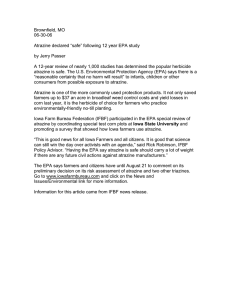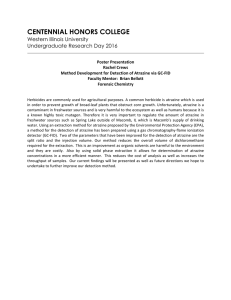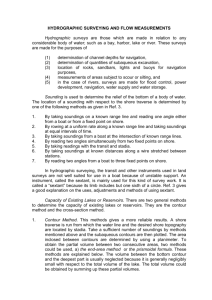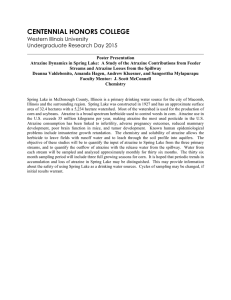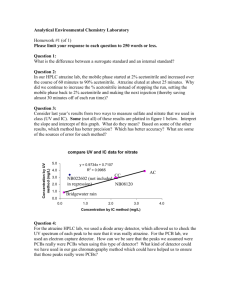Title: 1. Impact herbicide efficacy, crop tolerance, and carryover studies Stayton
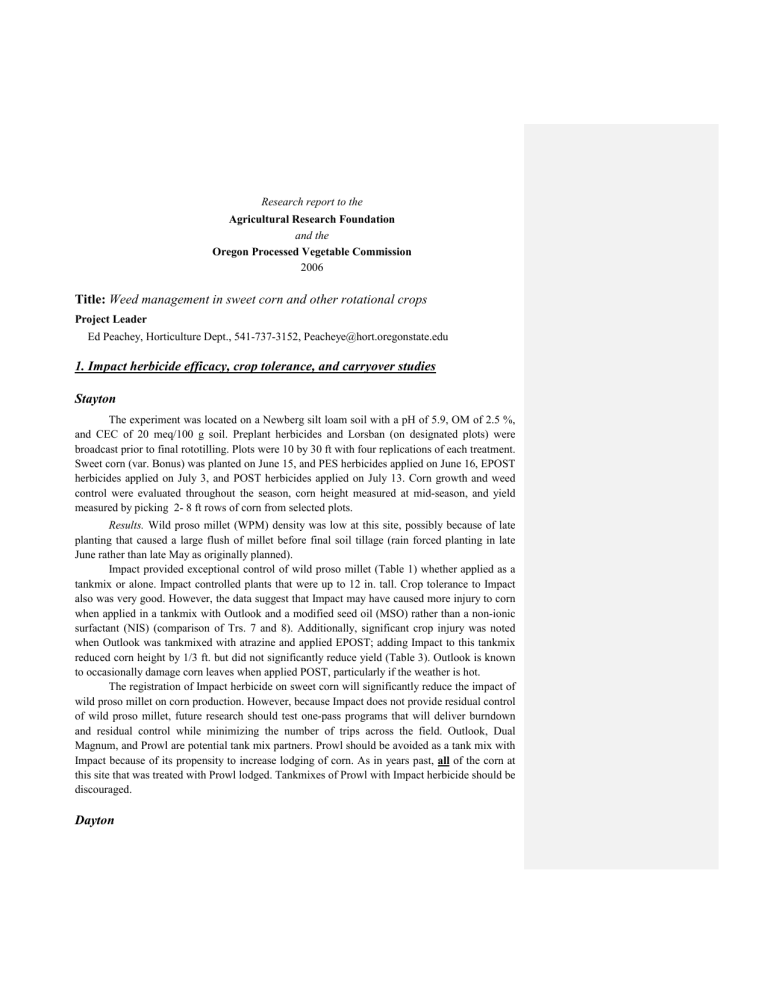
Research report to the
Agricultural Research Foundation and the
Oregon Processed Vegetable Commission
2006
Title: Weed management in sweet corn and other rotational crops
Project Leader
Ed Peachey, Horticulture Dept., 541-737-3152, Peacheye@hort.oregonstate.edu
1. Impact herbicide efficacy, crop tolerance, and carryover studies
Stayton
The experiment was located on a Newberg silt loam soil with a pH of 5.9, OM of 2.5 %, and CEC of 20 meq/100 g soil. Preplant herbicides and Lorsban (on designated plots) were broadcast prior to final rototilling. Plots were 10 by 30 ft with four replications of each treatment.
Sweet corn (var. Bonus) was planted on June 15, and PES herbicides applied on June 16, EPOST herbicides applied on July 3, and POST herbicides applied on July 13. Corn growth and weed control were evaluated throughout the season, corn height measured at mid-season, and yield measured by picking 2- 8 ft rows of corn from selected plots.
Results. Wild proso millet (WPM) density was low at this site, possibly because of late planting that caused a large flush of millet before final soil tillage (rain forced planting in late
June rather than late May as originally planned).
Impact provided exceptional control of wild proso millet (Table 1) whether applied as a tankmix or alone. Impact controlled plants that were up to 12 in. tall. Crop tolerance to Impact also was very good. However, the data suggest that Impact may have caused more injury to corn when applied in a tankmix with Outlook and a modified seed oil (MSO) rather than a non-ionic surfactant (NIS) (comparison of Trs. 7 and 8). Additionally, significant crop injury was noted when Outlook was tankmixed with atrazine and applied EPOST; adding Impact to this tankmix reduced corn height by 1/3 ft. but did not significantly reduce yield (Table 3). Outlook is known to occasionally damage corn leaves when applied POST, particularly if the weather is hot.
The registration of Impact herbicide on sweet corn will significantly reduce the impact of wild proso millet on corn production. However, because Impact does not provide residual control of wild proso millet, future research should test one-pass programs that will deliver burndown and residual control while minimizing the number of trips across the field. Outlook, Dual
Magnum, and Prowl are potential tank mix partners. Prowl should be avoided as a tank mix with
Impact because of its propensity to increase lodging of corn. As in years past, all of the corn at this site that was treated with Prowl lodged. Tankmixes of Prowl with Impact herbicide should be discouraged.
Dayton
Sweet corn (var. Punch) was strip-till planted and Dual Magnum and atrazine applied by the grower after planting. Significant rainfall shortly after planting eliminated the efficacy of
Dual Magnum and provided a good flush of wild proso millet seedlings. All treatments were applied on July 14. Crop growth and weed control were evaluated throughout the season and corn harvested from 2- 8 ft sections of one row. Only treatments that had 3 replications remaining were harvested, because the grower inadvertently harvested some of the plots on one side of the experiment.
Results.
WPM density at this site was great enough to reduce sweet corn yield. However, corn growth was highly variable within the experiment and treatment effects on corn yield were difficult to ascertain. The Check treatment only yielded 5.3 t/A, even though the plots of this treatment had Dual Magnum and atrazine applied to them after planting (Table 4). Impact controlled WPM very well in all treatments, and in some cases controlled millet that was 14 inches tall. Tank mixing Impact and Accent did not significantly improve weed control, but did significantly increase crop injury. Lowering the rate of MSO that was applied with Impact (from
1% to 0.25%) may have reduced WPM control and yield compared to Impact applied with 1%
MSO. The addition of UAN did not improve WPM control. Impact killed WPM and reduced competition with the corn crop, but did not stop WPM seed production. Whether this will result in a decline in seed density in the soil over time is unknown. Strategies should be developed that provide residual control of WPM as well as the burndown provided by Impact herbicide.
Lebanon (Puncturevine control)
The experiment was located on a Chehalis silty clay loam with a pH of 6.0, OM of 3.8% and CEC of 31.2 meq/100 g of soil. The soil was pre-irrigated before planting because of very dry conditions in May. Eradicane was sprayed on selected plots and incorporated within a dynadrive within 10 minutes. Rain promptly began to fall and created a less than perfect seedbed. Sweet corn was planted on May 19 into very wet soil and PES herbicides applied on May
20. On June 16, all of the emerged puncturevine seedlings were flagged, and POST treatments were applied on June 20 to puncturevine that had 4-6 true leaves. Puncturevine survival was recorded on June 30, and seedlings counted, recorded and removed from the plot the remainder of the season.
Results.
Puncturevine was not evenly distributed at this site, thus weed control evaluations were difficult to make. Nearly all of the puncturevine seedlings died after application of Impact and
Callisto herbicides, but puncturevine continued to emerge and many began to produce seeds later in the season (Table 6). The low number of puncturevine recorded in the untreated plots was either do to the location of the plots (randomly assigned to areas with a low density of seeds), or possibly due to the other weeds that emerged faster and kept the soil temperatures low. Prowl
+atrazine and Eradicane + Outlook produced the greatest number of seedlings, but once again it is unclear whether this was a plot placement or treatment effect. These plots were nearly devoid of other weeds, which may have encouraged puncturevine emergence. Another possibility, but unlikely, is that these herbicides stimulated puncturevine emergence. This will be tested in the lab.
Corvallis (carryover study)
The experimental design for the experiment was a strip plot, with herbicide rate, followcrop, and planting season as the subplots. Four varieties of sweet corn were planted on May 19 in rows 2.5 ft apart. All plots were replicated 4 times. Impact herbicide was applied to subplots within the sweet corn planting on June 28 at 0.016 and 0.032 lbs ai/A, with one of the subplots of each replicate block not receiving any herbicide. The two herbicide treatments were applied with a back pack sprayer with a 10 ft boom with 15 GPA of water. A few sunflowers were seeded with the corn as an indicator crop, and the solution that remained after the application was measured to ensure that the intended rate was applied. Soil analysis is in process.
Following corn harvest on September 11, the plots were prepared for planting by immediately flailing the corn as close to the soil surface as possible, disking (2x), and rototilling with a vertical tine tiller (2X with Rotera). The residue was allowed to decompose for 9 days to facilitate planting. Crimson clover, perennial ryegrass, forage fescue, processing squash (Golden
Delicious), snap beans (OR91G), sugar beets, and Chinese cabbage were planted on September
20, 85 days after Impact herbicide was applied to the corn. Pyramin was applied to the beets and
Devrinol to the Chinese cabbage PES to minimize winter weed competition with the crop.
Irrigation was needed to establish the crops. Emerged crop seedlings were counted on Oct. 13, 23 days after the crops were seeded, and growth and phytotoxicity rated 6 WAP.
Results.
There was no evidence of growth reduction or phytotoxicity for any of the crops at 6
WAP (Figure 1) or to date (Dec 22) that indicate Impact herbicide is affecting crop growth. Snap bean and sugar beet emergence counts were slightly reduced in plots with the 2X rate of Impact.
Additional crops will be planted in the spring including broccoli, peas, peppermint, perennial ryegrass, snap beans, squash, sugarbeets, and turf-type tall fescue. All crops will be harvested next summer.
Table 1.
Weed control and sweet corn response to Impact herbicide, Stayton, OR, 2006.
No. Product Rate Timing Phytotoxicity Stunting Corn height
7-13-06
10 DA
EPOST
7-15-06
12 DA
EPOST
7-13-06
10 DA
EPOST
7-15-06
12 DA
EPOST
8-9-06
4 WA POST
WPM density
7-27-06 lbs ai/A or % 0-10 % (0-100) Ft.
No/240 ft
2
4
3
1 Untreated
SEQUENTIAL
2 Eradicane
Outlook
Eradicane
Lorsban
Outlook
Outlook
Impact
MSO
UAN 28%
8
9
10
11
7
6
5 Outlook
Impact
Atrazine
MSO
0.84
0.016
0.5
1 %
EARLY POSTEMERGENCE
Outlook
Atrazine
MSO
UAN 32%
0.84
0.5
1 %
2.5 %
Impact
Outlook
Atrazine
NIS
UAN 28%
0.016
0.84
0.5
0.25 %
2.5 %
Impact
Outlook
Atrazine
MSO
UAN 32%
Callisto
Outlook
Atrazine
UAN 32%
Prowl H2O
Atrazine
MSO
UAN 32%
Impact
Prowl H2O
Atrazine
MSO
UAN 32%
0.016
0.84
0.5
1 %
2.5 %
0.094
0.84
0.5
2.5 %
1.66
0.5
1 %
2.5 %
016
1.66
0.5
1 %
2.5 %
4.2
0.84
4.2
2.0
0.84
0.84
016
1 %
2.5 %
V2-3
V2-3
V2-3
V2-3
V2-3
V2-3
V2-3
V2-3
V2-3
V2-3
V2-3
V2-3
V2-3
V2-3
V2-3
V2-3
V2-3
V2-3
V2-3
V2-3
V2-3
V2-3
V2-3
V2-3
V2-3
V2-3
V2-3
PRE
V2-3
V2-3
V2-3
PRE
V2-3
V2-3
V2-3
PPI
PRE
PPI
PPI
PRE
1.8
1.8
0.9
0.8
1.5
0.6
0.8
0
0
0
0
0
0.3
0
0
0
0
0
0
0.5
0
0
4
0
0
0
1
0
1
3
0
0
0
100
98
83
100
55
100
100
98
100
-
84
5
8
3
0
15
0
8
0
10
0
0
4.8
5.1
5.2
5.4
5.2
5.2
4.7
5.4
4.7
5.4
5.1
0.5
0.3
6.3
0
14.5
0.5
0
0.5
0
7.5
2.0
WPM control
8-9-06
%
Table 1, cont’d
No. Product
14
13
15
POSTEMERGENCE
12 Impact
Accent
Atrazine
MSO
UAN 32%
Impact
Option
Atrazine
MSO
UAN 32%
Impact
Atrazine
MSO
UAN 32%
Impact
Atrazine
Renegade
16 Impact
Atrazine
Renegade
Inplace
17
18
Impact
MSO
UAN 32%
Accent
Atrazine
COC
19 Accent
Aim
COC
LSD (0.05) lbs ai/A or %
0.016
0.5
1.75
0.75
0.016
1
2.5 %
0.032
0.5
1%
0.032
0.008
1%
0.016
031
0.5
1 %
2.5 %
0.016
0.033
0.5
1.000
2.5 %
0.016
0.5
1 %
2.5
0.016
0.5
1.75
V4-5
V4-5
V4-5
V4-5
V4-5
V4-5
V4-5
V4-5
V4-5
V4-5
V4-5
V4-5
V4-5
V4-5
V4-5
V4-5
V4-5
V4-5
V4-5
V4-5
V4-5
V4-5
V4-5
V4-5
V4-5
V4-5
V4-5
V4-5
V4-5
V4-5
Rate Timing
0
1.3
2.8
1.5
0
0
1.5
0.8
1.0
0.3
0
2.5
5.0
0.7
0
3.0
0
3.3
Phytotoxicity
7-13-06
10 DA
EPOST
7-15-06
12 DA
EPOST
7-13-06
10 DA
EPOST
Stunting
7-15-06
12 DA
EPOST
Corn height
8-9-06
4 WA POST
0-10 % (0-100) Ft.
WPM density
7-27-06
No/240 ft
2
WPM control
8-9-06
%
0
15
28
9
3
0
28
0
18
2
0
20
32
12
0
0
12
15
5.3
5.5
5.2
4.9
0.5
5.3
5.3
5.4
5.5
0.5
1.0
2.0
0.8
3.8
0.3
0.8
0.5
0
100
100
99
100
25
100
98
100
100
Formatted: Font: Italic
Table 2.
Herbicide and weed control effects on sweet corn yields, Stayton, OR, 2006.
No. Product Rate Timing Corn yield
3
1 Untreated
SEQUENTIAL
2 Eradicane
Outlook
Eradicane
Lorsban
Outlook
4
5
Outlook
Impact
MSO
UAN 28%
Outlook
Impact
Atrazine
MSO
8
EARLY POSTEMERGENCE
6 Outlook
Atrazine
MSO
UAN 32%
Impact
Outlook
Atrazine
MSO
UAN 32%
15
12
14
9 Callisto
Outlook
Atrazine
UAN 32%
POSTEMERGENCE
Impact
Accent
Atrazine
MSO
UAN 32%
Impact
Atrazine
MSO
UAN 32%
Impact
Atrazine
Renegade lbs ai/A or %
0.84
0.5
1 %
2.5 %
0.016
0.84
0.5
1 %
2.5 %
0.094
0.84
0.5
2.5 %
0.016
031
0.5
1 %
2.5 %
0.016
0.5
1 %
2.5
0.016
0.5
1.75
4.2
0.84
4.2
2.0
0.84
0.84
016
1 %
2.5 %
0.84
0.016
0.5
1 %
PRE
V2-3
V2-3
V2-3
PRE
V2-3
V2-3
V2-3
PPI
PRE
PPI
PPI
PRE
V2-3
V2-3
V2-3
V2-3
V2-3
V2-3
V2-3
V2-3
V2-3
V2-3
V2-3
V2-3
V2-3
V4-5
V4-5
V4-5
V4-5
V4-5
V4-5
V4-5
V4-5
V4-5
V4-5
V4-5
V4-5
Ear number
No./A
27446
28553
30545
26561
28221
26561
26893
29549
28221
29549
27889
12.2
10.9
11.3
11.1
11.2
11.7
11.5
12.3
12.1
Fresh wt yield t/A
12.4
11.9
Avg. ear wt. kg
0.43
0.38
0.37
0.36
0.38
0.38
0.38
0.36
0.37
0.38
0.40
Husked ear avg. wt kg
0.26
0.27
0.26
0.24
0.26
0.26
0.21
0.27
0.26
0.27
0.26
Table 2, cont’d
No. Product
16 Impact
Atrazine
Renegade
Inplace
17 Impact
MSO
UAN 32%
18 Accent
Atrazine
COC
19 Accent
Aim
COC
LSD (0.05)
Rate lbs ai/A or %
0.016
0.5
1.75
0.75
0.016
1
2.5 %
0.032
0.5
1%
0.032
0.008
1%
Timing
V4-5
V4-5
V4-5
V4-5
V4-5
V4-5
V4-5
V4-5
V4-5
V4-5
V4-5
V4-5
V4-5
Corn yield
Ear number
No./A
26229
30213
30102
23462
4061
Fresh wt yield t/A
11.1
12.7
12.1
9.6 ns
Avg. ear wt. kg
0.38
0.38
0.36
0.37 ns
Husked ear avg. wt kg
0.27
0.27
0.26
026 ns
Formatted: Font: Italic
Table 3. Herbicide application data for Stayton site, 2006.
Date
Crop stage
Weeds and growth stage
Millet
Pigweed
June 14, 2006 June 24, 2006
Few millet have emerged
July 03, 2006
Planted 6/20/2006 V 2-3
Very few millet, cotyledon to1-2 inches tall
July 13, 2006
V4- some V5, up to 14 inches tall
4-leaf to 12 inch diameter plants with 6 leaves or more
12 inches tall
Application timing
Start/end time
Air temp/soil temp
(2")/surface
Relative humidity (%)
Dew point
Wind direction/velocity
Cloud cover
Soil moisture
Plant moisture
Sprayer/PSI
Mix size
Gallons H20/acre
Nozzle type
Nozzle spacing and height
Soil inc. method/implement
PPI
10-10:15
64/69/71
100
-
3-6 SE
100
Damp
-
PES
6-7 AM
62/64/62
80
-
0-0.5 SE
0
Dry
-
BP 30
2100
20
8003
20/18
Field cultivator and leveler within 15 min.
Rototilled on 6-16 before planting
BP40
2100
20
8003
20/18
Plan to irrigate next morning
EPOST (V2-3) POST (V4-5)
7-8 AM 6:30-8:00 AM
62/56/59 63/65/67
82
-
0-2.8 SW
0
Dry
Light dew
BP40
2100
20
8003
20/18
88
59
0-1.2 NW
100
Very wet - just irrigated day prior
Plants very wet - some collars filled with water
BP40
2100
20
8003
20/18
Irrigated yesterday
Table 4.
Weed control with Impact herbicide, Dayton, OR, 2006.
Herbicides 1 /surfactants
1 Check
2 Impact
Accent
Atrazine
MSO
UAN 28%
3 Impact
Atrazine
MSO
UAN 32%
4 Impact
Atrazine
Renegade 2
Inplace
Rate lbs ai/A or
%
0.016
0.031
0.500
1%
2.5%
0.016
0.500
1%
2.5%
0.016
0.500
1.75 pts/A
0.75 oz/A
Obs.
4
4
4
4
Phytotoxicity rating
----------0-10 ----------
0
3.8
0
0
0
1.5
0
0.3
0
13
0
3
0
3.0
0
0
Stunting
-----------%------------
10
40
15
0
0
43
0
0
WPM control
21-Jul 26-Jul 9-Aug 21-Jul 26-Jul 9-Aug 26-Jul 9-Aug
-------%--------
0
88
88
86
0
93
95
95
Obs
3
3
3
Ear count no/A
13458
-
17353
16645
Harvest
5 Impact (0.5 oz)
MSO
UAN 32%
6 Impact
MSO
0.011
1%
2.5%
0.016
0.25%
4
4
0
0
0
0
0
0
0
0
3
0
10
9
96
86
81
78
2
3
21780
12041
9.2
5.5
0.38
0.44
7 Impact
MSO
8 Impact
MSO
UAN 32%
9 Accent
Atrazine
MSO
UAN 32%
10 Accent
MSO + UAN (32%)
0.016
1%
0.016
1%
2.5%
0.032
0.500
1%
2.5%
0.032
4
4
4
4
0
0
3.0
3.5
0
0
3.0
3.5
0
0
2.5
3.0
0
0
25
30
0
0
30
35
3
8
35
19
93
97
89
90
85
90
91
93
4
3
-
-
20983
19832
-
-
9.3
8.8
-
-
FPLSD (0.05) 0.7 0.7 0.7 9 9 22 6 11 6210 2.4
1 Dual Magnum and atrazine were applied to the entire field at planting.
2
MSO = Super Spread (Wilbur Ellis); NIS = Preference (Agriliance); Renegade = modified vegetable oil and nitrogen blend (Wilbur Ellis); Inplace=deposition and drift management agent (Wilbur Ellis).
ns
0.40
0.40
-
-
Fresh wt. t/A
5.3
-
7.9
7.8
Avg. ear wt. kg
0.36
-
0.42
0.43
WPM control
%
0
-
82
78
-
28
74
80
-
83
67
Table 5.
Schedule and herbicide application data, Dayton, 2006.
Date
Crop stage
Weeds and growth stage
Friday, July 14, 2006 v5; 6-14 tall, irregular on this edge of field
Millet 2-4" tall; up to 8" in dia.
Lambsquarters 4-6 lf, very few
Application timing POST
Start/end time
Air temp/soil temp
(2")/surface
Relative humidity
Dew point
7-8 AM
70/72/72
65%
52%
Wind direction/velocity
Cloud cover
Soil moisture
0
0
Very dry, plans to irrigate within 12 hrs
Plant moisture
Sprayer/PSI
Mix size
Gallons H20/acre
Light dew
BP/40
2100 mls/4.8 plots
20
Nozzle type New 8002 and 50 screens
Nozzle spacing and height 20/24” above soil to avoid high conc. on corn whorls
Table 6.
Puncturevine control with Impact herbicide, Lebanon, 2006.
Herbicide Rate Timing Date Puncturevine density before EPOST app.
# plots
( 17-June) no./plot
EPOST control
2 WAT
(30-June)
%
Cumulative puncturevine density
(through 10-Aug) no./plot
6 Outlook
Atrazine
7 Prowl H2O
Atrazine
8 Outlook
Impact
NIS
UAN 32%
9 Outlook
Impact
Atrazine
NIS
UAN 32%
10 Impact
Outlook
Atrazine
NIS
UAN 32%
11 Callisto
Outlook
Atrazine
UAN 32%
1 Untreated
2 Eradicane
3 Outlook
4 Dual Magnum
5 Eradicane
Outlook
5 pts
1 pt
2 pts
5.0 pts
16 oz
16 oz
10 oz
2.0 pts
0.6 pt
16 oz
0.75 oz
0.25 %
2.5 %
16 oz
0.75 oz
10 oz
0.25 %
2.5 %
0.75 oz
12.0 oz
10 oz
0.25 %
2.5 %
3 oz
12.0 oz
10 oz
2.5 %
12 Impact
MSO
UAN 32%
13 Accent
Atrazine
COC
14 Atrazine
FPLSD (0.05)
0.75 oz
1.0 %
2.5 %
0.67 oz
10 oz
1 %
PRE
PPI
PRE
PRE
PPI
PES
19-May
20-May
20-May
19-May
20-May
PRE
PRE
20-May
20-May
PRE
PRE
20-May
20-May
PRE 20-May
EPOST 17-Jun
EPOST 17-Jun
EPOST 17-Jun
PRE 20-May
EPOST 17-Jun
EPOST 17-Jun
EPOST 17-Jun
EPOST 17-Jun
EPOST 17-Jun
EPOST 17-Jun
EPOST 17-Jun
EPOST 17-Jun
EPOST 17-Jun
EPOST 17-Jun
EPOST 17-Jun
EPOST 17-Jun
EPOST 17-Jun
EPOST 17-Jun
EPOST 17-Jun
EPOST 17-Jun
EPOST 17-Jun
EPOST 17-Jun
EPOST 17-Jun
20-May
1.3
2.0
0.3
7.8
0.8
1.5
0.5
0
0
0
10.5
0
0.8
6.8 ns
1
2
2
1
3
1
2
1
0
0
0
2
0
2
75
88
-
-
100
100
-
-
-
-
-
-
100
-
47
3.0
1.3
1.0
31.3
1.8
1.5
1.5
0.3
1.5
1.8
14.8
0.5
2.0
10.5
17.0
Table 7.
Application data for Lebanon site, 2006.
Date
Crop stage
Weeds and growth stage
Puncturevine
Pigweed
Nightshade
Lambsquarters
Application timing
Start/end time
Air temp/soil temp (2")/surface
Rel humidity
Wind direction/velocity
Cloud cover
Soil moisture
Plant moisture
Sprayer/PSI
Mix size
Gallons H20/acre
Nozzle type
Nozzle spacing and height
Soil inc. method/implement
Friday, May 19, 2006
PPI Eradicane
8:30-10:00
68.5/70.5/80.1
86%
1
Partly cloudy
Damp
BP 30
2100
20
5, 8003
20/18
Dynadrive within 10 minutes
Saturday, May 20, 2006
Planted 5-19 into very wet pre-irrigated soil with rainfall following during the night
PES
7-7:45
56/60/59
92%
0-1 W
Partly cloudy
Very, very, wet
BP 30
2100
20
5, 8003
20/18
Saturday, June 17, 2006
8” max, v3, 5-6 leaf
4-6 lf
4-6 lf
4-6 lf
4-8 lf
EPOST
7:20-8 amAM
62/64/65
82%
0-2 NW
90
Dry crusted
Dry
BP 40
2100
20
5, 8003
20/18
120
100
80
Emergence
4 WAP
(% of check)
60
40
20
*
0.75 oz 1.5 oz
0 snap beans chinese cabbage clover fescue ryegrass sugar beets squash
Figure 1. Effect of Impact herbicide on rotational crops planted 82 days after Impact herbicide was applied to sweet corn, Corvallis, 2006. The asterisk (*) indicates that snap bean emergence may have been lower compared to the untreated check when Impact was applied at 1.5 oz in June.
2. Seed predation potential in field crops
Background. Regulation of weed seed banks in agricultural systems primarily involves management of seed input from seed rain, and seed removal from mortality and germination. While seed rain, germination, and emergence are managed using a number of methods such as tillage and herbicides, management of seed mortality is frequently overlooked. Seed predation by invertebrates such as carabid beetles is a key source of mortality in many cropping systems.
Methods. During the summer and fall of 2006 we began to measure the seed predation potential of carabid beetles, and the use of crop and tillage rotational strategies to promote the establishment of seed predators in vegetable cropping systems. Sites were located both in western Oregon (5) and eastern Washington (4). Western Oregon sites were primarily conventional corn, beans and grass fields. Eastern Washington sites consisted of both organic and conventional corn and carrot fields.
Seed predation stations were placed in several areas of the field, along edges and in the middle. Each station included a pitfall trap to determine species in the field, and three types of exclosures over weed seed trays to calculate seed predation. The exclosures included one designed to exclude all mammals (mice) and insects, one that allowed insects but excluded mammals, and one that allowed entry of both mammals and insects. Fifty pigweed seeds were placed on 2 inch dia. Petri dishes under each exclosure and the number remaining after 7 to 14 days was recorded. Time lapse photography also was used to monitor removal of seeds by carabids and other invertebrates.
Results.
Seeds were removed from both the mammal exclosures (allow arthropod entry) and the total exclosures, although the number of seeds removed from the mammal exclosures was higher than the total exclosures. The number of seeds removed per day and the number of seed predators caught per day was greatest during August (Figure 2). The number of seeds removed and number of seed predators caught per day was greater in the bean crop than in the corn or carrots. The most prevalent species caught in the fields included Pterosticus melanarius, Harpalus pennsylvanicus, Harpalus affinius, Amara aenea, and Agonum melanarium . P. melanarius was the primary large carabid species on the west side and H. pennsylvanicus was the primary large species in the eastern
Washington fields.
Discussion. Regression analysis suggests a correlation between number of insects and seeds removed from the total exclosures. Although seeds were removed from the seed stations by invertebrates as predicted, they were also removed from exclosures designed to exclude both insects and mammals.
Time lapse photography suggests that the removal may be due to seed sticking to earthworms and slugs that crawl across the seed plates. Modifications to the exclosures will include a bottom barrier to prevent both earthworms and soil dwelling and burrowing arthropods entry by emerging through the soil surface.
Figure 2. Effect of collection date on number of carabids (potential seed predators) trapped and weed seed loss per day averaged over both East and West sites. Error bars are standard deviation (n=40 to 50).
